Ground Clutter Mitigation for Slow-Time MIMO Radar Using Independent Component Analysis
Abstract
1. Introduction
2. Signal Modeling of St-MIMO Radar
2.1. St-MIMO Waveform Modeling and Processing
2.2. Ground Clutter Modeling under St-MIMO Framework
3. St-MIMO-ICA Processing
3.1. Signal Modeling under ICA Compliance
3.2. St-MIMO-ICA Processing
- Whitening:The covariance matrix of the observed signal can be expressed as:By applying eigenvalue decomposition to the covariance matrix, one can obtain:Then, the whitening matrix can be denoted as:and the whitened matrix can be achieved.
- Formulating the optimization problemA cost function based on maximizing the negentropy can be express as:where is a smooth even function and is the weight matrix used to de-mix the observed signal and obtain the estimated source matrix . Then, the optimization problem is formulated as:Here, we chose as the function motivated by kurtosis.
- Fixed-point updating processThe fixed-point algorithm is utilized to update the weight matrix in each iteration and can be expressed as:where and . The third term of Equation (43) includes the second-order information in terms of the pseudo-covariance matrix , which is non-zero if the sources are noncircular. This modification ensures that the nc-FastICA method has an improved separation performance with noncircular sources.
- Obtain the weight matrix and estimated source matrixThe estimation of the observation matrix can be expressed as:where is the estimated source matrix with source vectors and is the weight matrix with corresponding weight vectors.It is worth noting that the number of sources separated by the ICA method is no more than the channel number . When the number of sources in the mixed signal is less than the number of the channels, those redundant channels will contain noise signals [22]. In this case, the PCA method can be utilized to decrease the dimensions of the data for the following ICA processing. However, this part is beyond the scope of this paper.
4. Experimental Results
4.1. Simulation Results
4.2. Field Experimental Results
5. Discussion
Author Contributions
Funding
Institutional Review Board Statement
Informed Consent Statement
Data Availability Statement
Acknowledgments
Conflicts of Interest
References
- Patel, J.; Fioranelli, F.; Anderson, D. Review of radar classification and RCS characterisation techniques for small UAVs or drones. IET Radar Sonar Navigat. 2018, 12, 911–919. [Google Scholar] [CrossRef]
- Zhao, C.; Luo, G.; Wang, Y.; Chen, C.; Wu, Z. UAV Recognition Based on Micro-Doppler Dynamic Attribute-Guided Augmentation Algorithm. Remote Sens. 2021, 13, 1205. [Google Scholar] [CrossRef]
- Raja Abdullah, R.S.A.; Alhaji Musa, S.; Abdul Rashid, N.E.; Sali, A.; Salah, A.A.; Ismail, A. Passive Forward-Scattering Radar Using Digital Video Broadcasting Satellite Signal for Drone Detection. Remote Sens. 2020, 12, 3075. [Google Scholar] [CrossRef]
- Aldowesh, A.; BinKhamis, T.; Alnuaim, T.; Alzogaiby, A. Low power digital array radar for drone detection and micro-Doppler classification. In Proceedings of the 2019 Signal Processing Symposium (SPSympo), Krakow, Poland, 17–19 September 2019; pp. 203–206. [Google Scholar]
- Aldowesh, A.; Alnuaim, T.; Alzogaiby, A. Slow-moving micro-UAV detection with a small scale digital array radar. In Proceedings of the 2019 IEEE Radar Conference (RadarConf), Boston, MA, USA, 22–26 April 2019; pp. 1–5. [Google Scholar]
- Yang, F.; Qu, K.; Hao, M.; Liu, Q.; Chen, X.; Xu, F. Practical investigation of a MIMO radar system for small drones detection. In Proceedings of the 2019 International Radar Conference (RADAR), Toulon, France, 23–27 September 2019; pp. 1–5. [Google Scholar]
- Yang, F.; Xu, F.; Fioranelli, F.; Le Kernec, J.; Chang, S.; Long, T. Practical investigation of a MIMO radar system capabilities for small drones detection. IET Radar Sonar Navigat. 2021, 15, 760–774. [Google Scholar] [CrossRef]
- Hao, M.; Yang, F.; Liu, Q. Slow-time MIMO radar waveform generator with experimental results. In Proceedings of the 2019 IEEE International Conference on Signal, Information and Data Processing (ICSIDP), Chongqing, China, 11–13 December 2019; pp. 1–5. [Google Scholar]
- Ritchie, M.; Fioranelli, F.; Griffiths, H.; Torvik, B. Monostatic and bistatic radar measurements of birds and micro-drone. In Proceedings of the 2016 IEEE Radar Conference (RadarConf), Philadelphia, PA, USA, 2–6 May 2016; pp. 1–5. [Google Scholar]
- Palamà, R.; Fioranelli, F.; Ritchie, M.; Inggs, M.; Lewis, S.; Griffiths, H. Measurements and discrimination of drones and birds with a multi-frequency multistatic radar system. IET Radar Sonar Navigat. 2021, 15, 841–852. [Google Scholar] [CrossRef]
- de Quevedo, Á.D.; Urzaiz, F.I.; Menoyo, J.G.; López, A.A. Drone detection and radar-cross-section measurements by RAD-DAR. IET Radar Sonar Navigat. 2019, 13, 1437–1447. [Google Scholar] [CrossRef]
- Jahangir, M.; Baker, C. Persistence surveillance of difficult to detect micro-drones with L-band 3-D holographic radar™. In Proceedings of the 2016 CIE International Conference on Radar (RADAR), Guangzhou, China, 10–13 October 2016; pp. 1–5. [Google Scholar]
- Jahangir, M.; Baker, C.J.; Oswald, G.A. Doppler characteristics of micro-drones with L-Band multibeam staring radar. In Proceedings of the 2017 IEEE Radar Conference (RadarConf), Seattle, WA, USA, 8–12 May 2017; pp. 1052–1057. [Google Scholar]
- Park, J.; Jung, D.-H.; Bae, K.-B.; Park, S.-O. Range-Doppler map improvement in FMCW radar for small moving drone detection using the stationary point concentration technique. IEEE Trans. Microw. Theory Technol. 2020, 68, 1858–1871. [Google Scholar] [CrossRef]
- Sun, H.; Oh, B.-S.; Guo, X.; Lin, Z. Improving the Doppler resolution of ground-based surveillance radar for drone detection. IEEE Trans. Aerosp. Electron. Syst. 2019, 55, 3667–3673. [Google Scholar] [CrossRef]
- Chen, X.; Guan, J.; Chen, W.; Zhang, L.; Yu, X. Sparse long-time coherent integration-based detection method for radar low-observable manoeuvring target. IET Radar Sonar Navigat. 2020, 14, 538–546. [Google Scholar] [CrossRef]
- Sun, Y.; Abeywickrama, S.; Jayasinghe, L.; Yuen, C.; Chen, J.; Zhang, M. Micro-Doppler signature-based detection, classification, and localization of small UAV with long short-term memory neural network. IEEE Trans. Geosci. Remote Sens. 2021, 59, 6285–6300. [Google Scholar] [CrossRef]
- Oh, B.-S.; Lin, Z. Extraction of global and local micro-Doppler signature features from FMCW radar returns for UAV detection. IEEE Trans. Aerosp. Electron. Syst. 2021, 57, 1351–1360. [Google Scholar] [CrossRef]
- Guo, J.; Chang, S.; Yang, F.; Cai, J.; Liu, Q.; Long, T. Low-slow-small target detection using stepped-frequency signals in a strong folded clutter environment. IET Radar Sonar Navigat. 2021, 15, 1030–1044. [Google Scholar] [CrossRef]
- Aircraft Birdstrike Avoidance Radar. Available online: https://detect-inc.com/aircraft-birdstrike-avoidance-radar (accessed on 1 September 2021).
- Smart, Affordable Drone Detection Radar. Available online: https://www.robinradar.com/iris-counter-drone-radar (accessed on 1 March 2020).
- Hyvärinen, A.; Karhunen, J.; Oja, E. Independent Component Analysis; John Wiley & Sons, Inc.: Hoboken, NJ, USA, 2001; pp. 151–154. [Google Scholar]
- Cardoso, J.-F. Blind signal separation: Statistical principles. Proc. IEEE Proc. 1998, 86, 2009–2025. [Google Scholar] [CrossRef]
- Cardoso, J.-F. Higher order contrast for independent component analysis. Neural Comput. 1999, 11, 157–193. [Google Scholar] [CrossRef]
- Cui, G.; Yu, X.; Carotenuto, V.; Kong, L. Space-Time Transmit Code and Receive Filter Design for Colocated MIMO Radar. IEEE Signal Process. 2017, 65, 1116–1129. [Google Scholar] [CrossRef]
- Yu, X.; Cui, G.; Yang, J.; Kong, L. MIMO Radar Transmit–Receive Design for Moving Target Detection in Signal-Dependent Clutter. IEEE Trans. Veh. Technol. 2020, 69, 522–536. [Google Scholar] [CrossRef]
- Cheng, Z.; He, Z.; Liao, B.; Fang, M. MIMO Radar Waveform Design With PAPR and Similarity Constraints. IEEE Signal Process. 2018, 66, 968–981. [Google Scholar] [CrossRef]
- Mecca, V.F.; Ramakrishnan, D.; Krolik, J.L. MIMO radar space-time adaptive processing for multipath clutter mitigation. In Proceedings of the Fourth IEEE Workshop on Sensor Array and Multichannel Processing, Waltham, MA, USA, 12–14 July 2006; pp. 249–253. [Google Scholar]
- Bliss, D.W.; Forsythe, K.W.; Davis, S.K.; Fawcett, G.S.; Rabideau, D.J.; Horowitz, L.L.; Kraut, S. GMTI MIMO radar. In Proceedings of the 2009 International Waveform Diversity and Design Conference, Kissimmee, FL, USA, 8–13 February 2009; pp. 118–122. [Google Scholar]
- Li, J.; Stoica, P. MIMO Radar Signal Processing; John Wiley & Sons, Inc.: Hoboken, NJ, USA, 2009; pp. 293–297. [Google Scholar]
- Mecca, V.F.; Krolik, J.L. Slow-time MIMO STAP with improved power efficiency. In Proceedings of the 2007 Conference Record of the Forty-First Asilomar Conference on Signals, Systems and Computers, Pacific Grove, CA, USA, 4–7 November 2007; pp. 202–206. [Google Scholar]
- Mecca, V.F.; Krolik, J.L.; Robey, F.C. Beamspace slow-time MIMO radar for multipath clutter mitigation. In Proceedings of the 2008 IEEE International Conference on Acoustics, Speech and Signal Processing, Las Vegas, NV, USA, 31 March–4 April 2008; pp. 2313–2316. [Google Scholar]
- Zhu, L.; Zhang, S.; Ma, Q.; Zhao, H.; Chen, S.; Wei, D. Classification of UAV-to-ground targets based on enhanced micro-Doppler features extracted via PCA and compressed sensing. IEEE Sens. J. 2020, 20, 14360–14368. [Google Scholar] [CrossRef]
- Dou, D.; Li, M.; He, Z. Multi-mode clutter suppression of multiple-input–multiple-output over-the-horizon radar based on blind source separation. IET Radar Sonar Navigat. 2015, 9, 956–966. [Google Scholar] [CrossRef]
- Yu, W.; Chen, J.; Bao, Z. Multi-mode propagation mode localisation and spread-Doppler clutter suppression method for multiple-input multiple-output over-the-horizon radar. IET Radar Sonar Navigat. 2019, 13, 1214–1224. [Google Scholar] [CrossRef]
- Ge, M.; Cui, G.; Yu, X.; Kong, L. Main lobe jamming suppression via blind source separation sparse signal recovery with subarray configuration. IET Radar Sonar Navig. 2020, 14, 431–438. [Google Scholar] [CrossRef]
- Robey, F.C.; Coutts, S.; Weikle, D.; McHarg, J.C.; Cuomo, K. MIMO radar theory and experimental results. In Proceedings of the Thirty-Eighth Asilomar Conference on Signals, Systems and Computers, Pacific Grove, CA, USA, 7–10 November 2004; pp. 300–304. [Google Scholar]
- Wen, C.; Huang, Y.; Peng, J.; Wu, J.; Zheng, G.; Zhang, Y. Slow-time FDA-MIMO technique with application to STAP radar. IEEE Trans. Aerosp. Electron. Syst. 2022, 58, 74–95. [Google Scholar] [CrossRef]
- Xu, J.; Peng, Y.; Wan, Q.; Wang, X.; Xia, X. Doppler distributed clutter model of airborne radar and its parameters estimation. Sci. China Inf. Sci. 2004, 47, 577–586. [Google Scholar] [CrossRef]
- Hyvärinen, A.; Oja, E. Independent component analysis: Algorithms and applications. Neural Netw. 2000, 13, 411–430. [Google Scholar] [CrossRef] [PubMed]
- Novey, M.; Adali, T. On extending the complex FastICA algorithm to noncircular sources. IEEE Trans. Signal Process. 2008, 56, 2148–2154. [Google Scholar] [CrossRef]
- Zhang, H.; Liu, W.; Shi, J.; Fei, J.; Zong, B. Joint detection threshold optimization and illumination time allocation strategy for cognitive tracking in a networked radar system. IEEE Trans. Signal Process. 2008; early access. [Google Scholar]
- Yan, J.; Pu, W.; Zhou, S.; Liu, H.; Bao, Z. Collaborative detection and power allocation framework for target tracking in multiple radar system. Inf. Fusion 2020, 55, 173–183. [Google Scholar] [CrossRef]
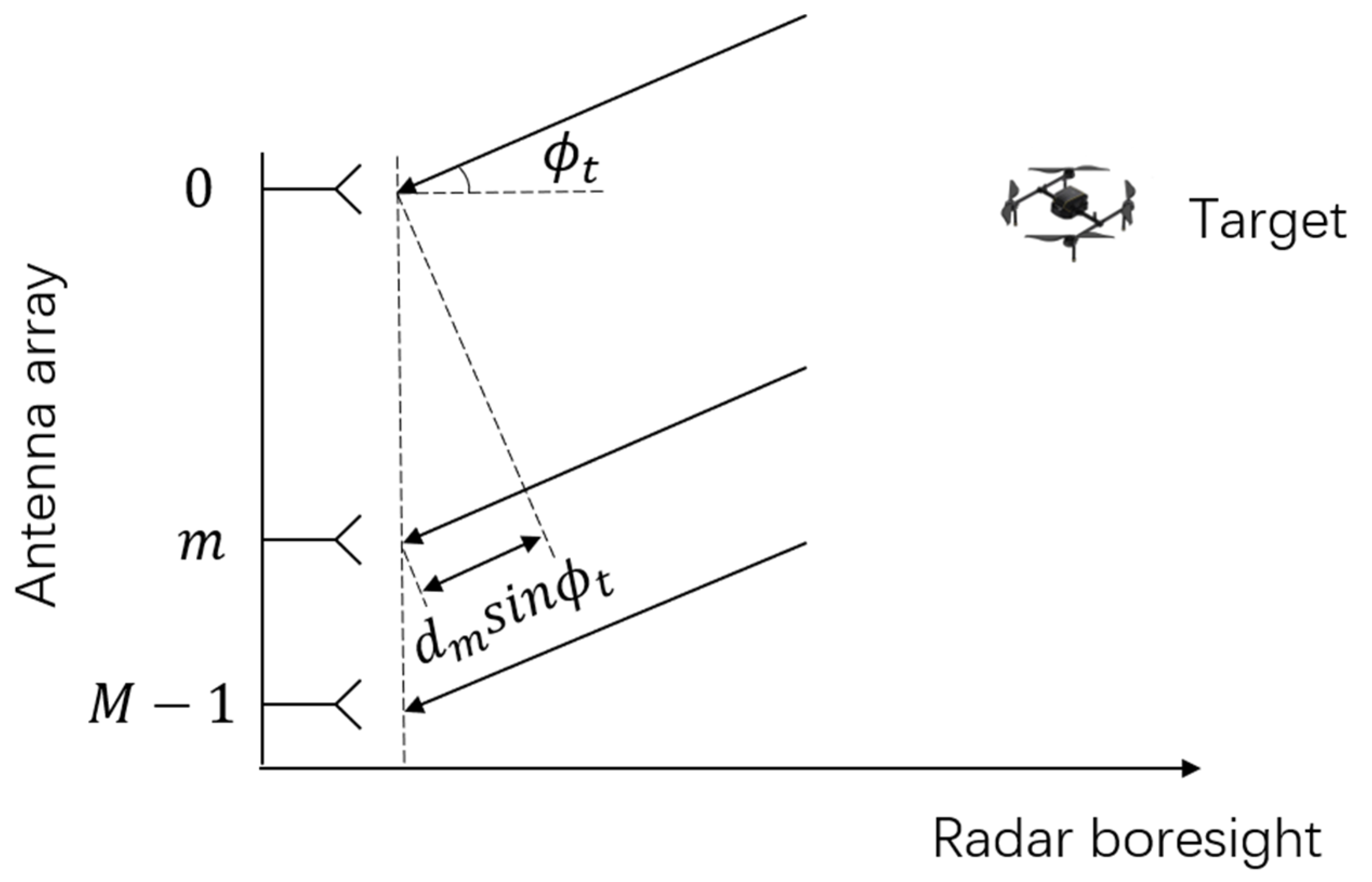
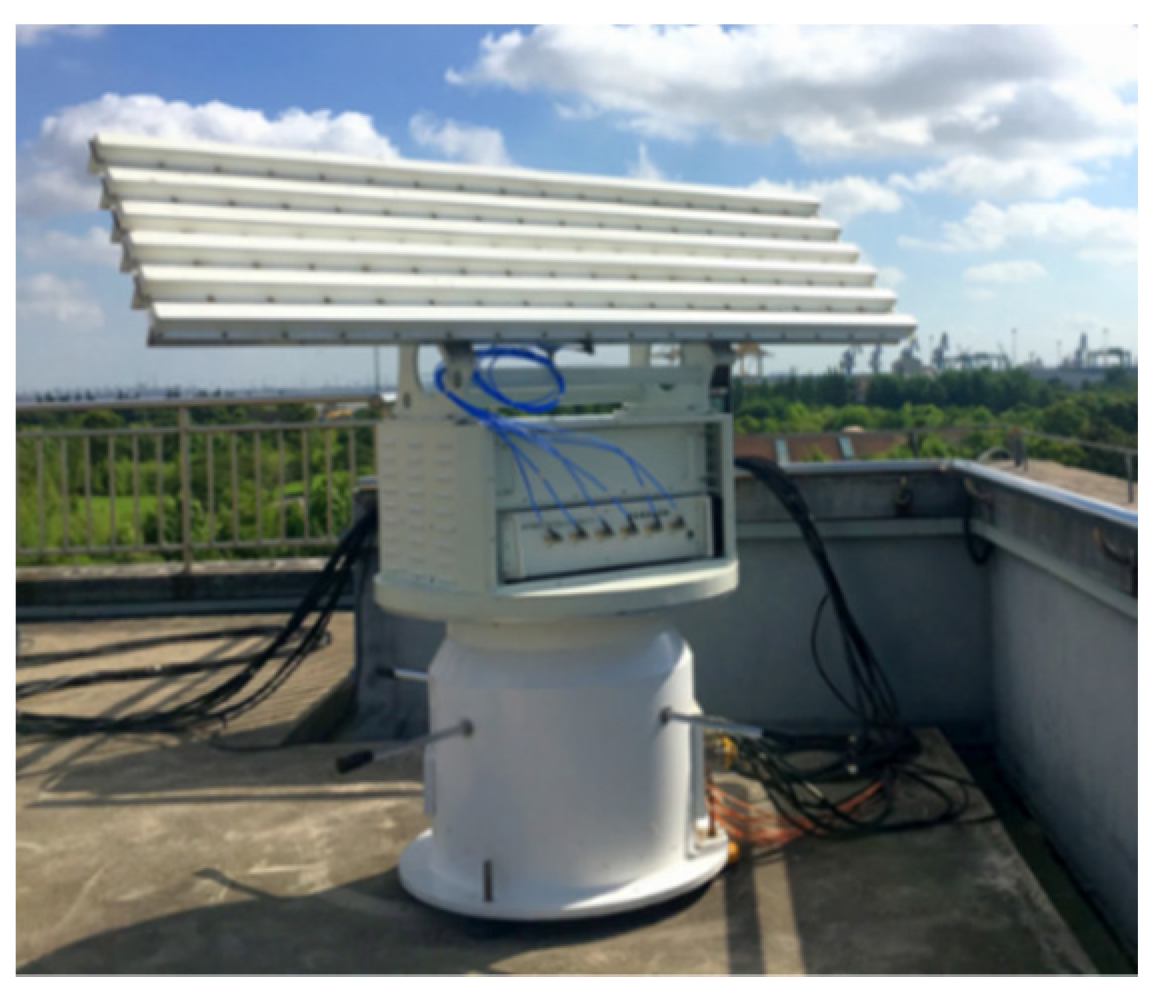
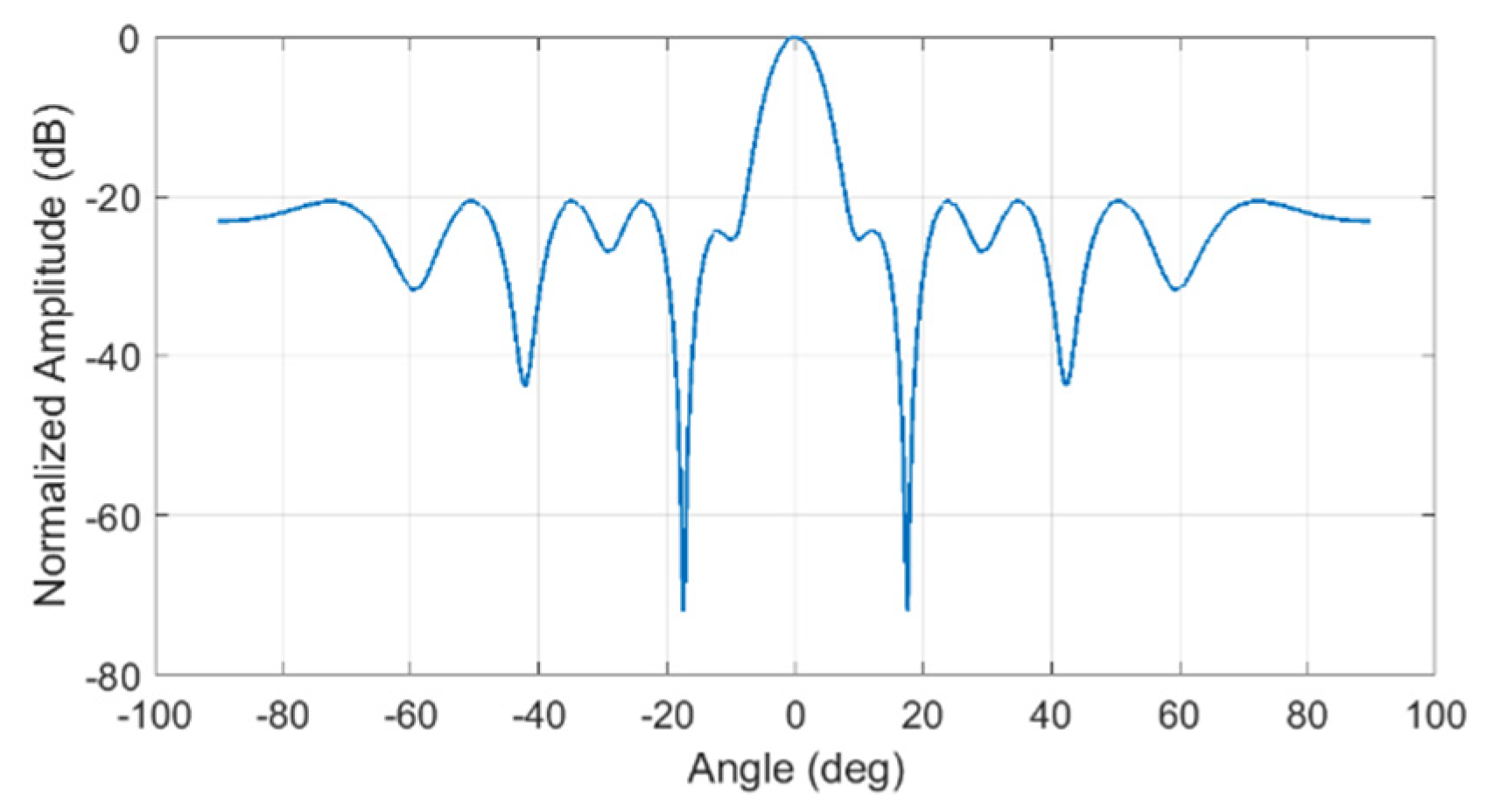
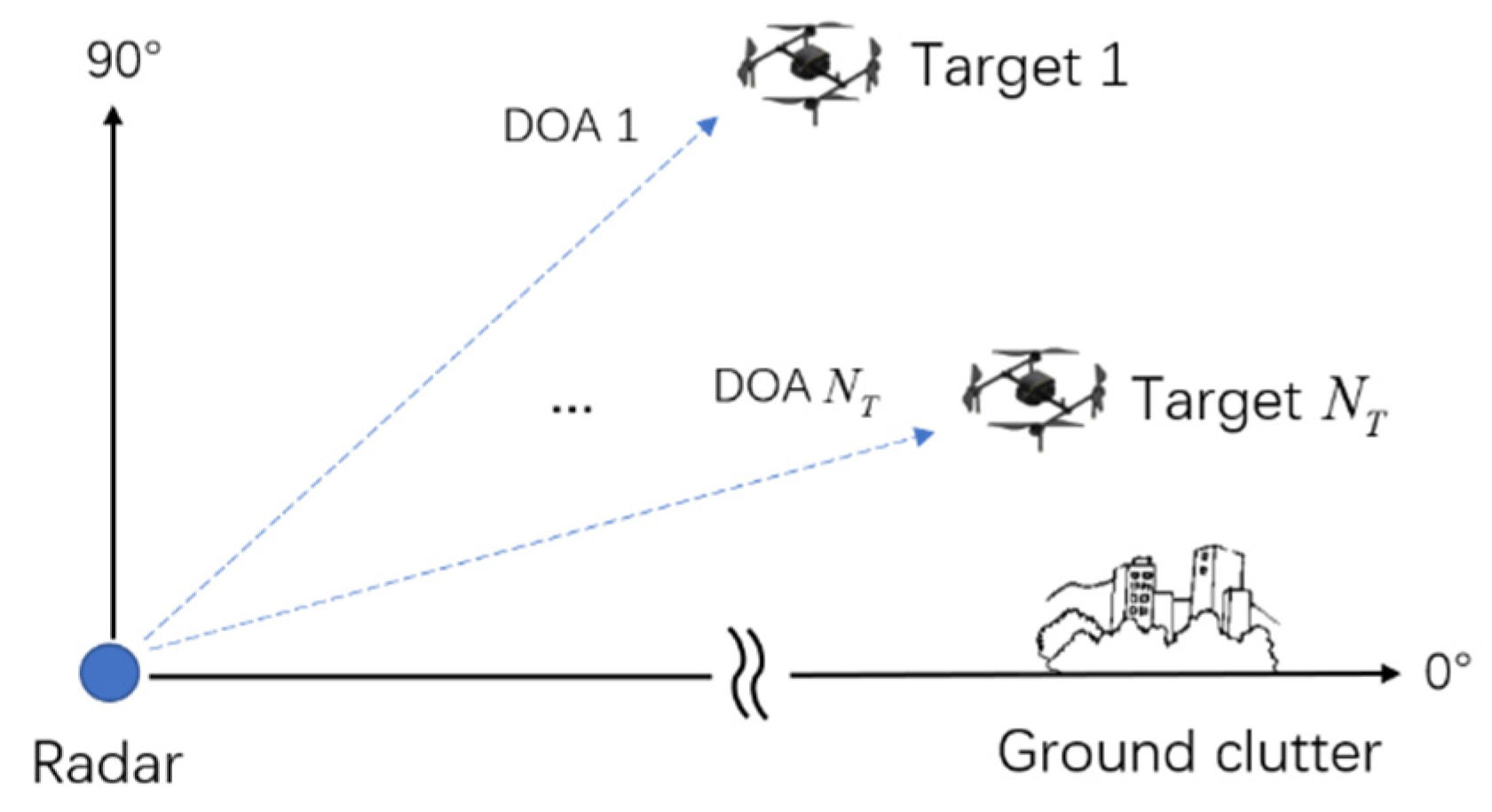

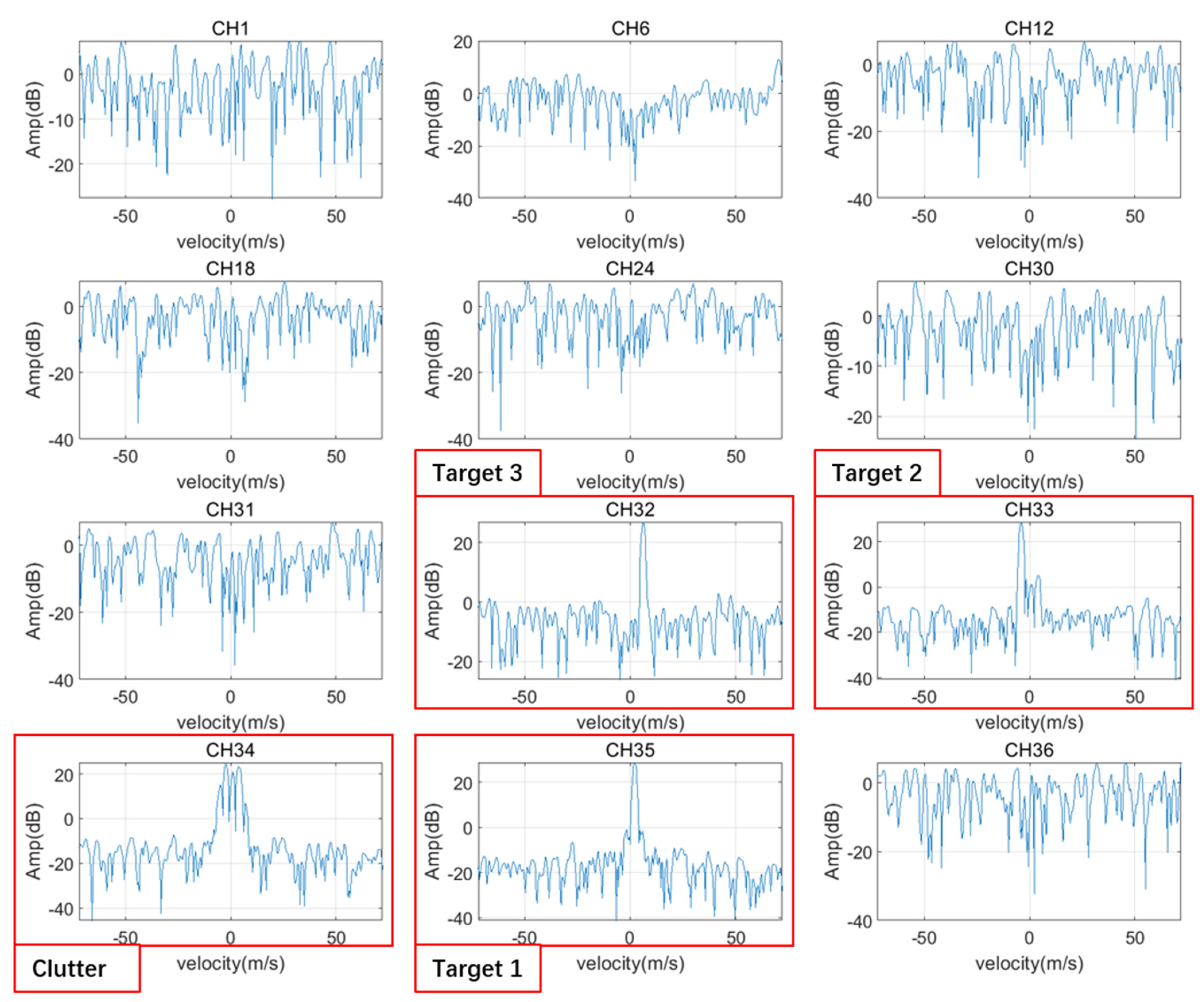


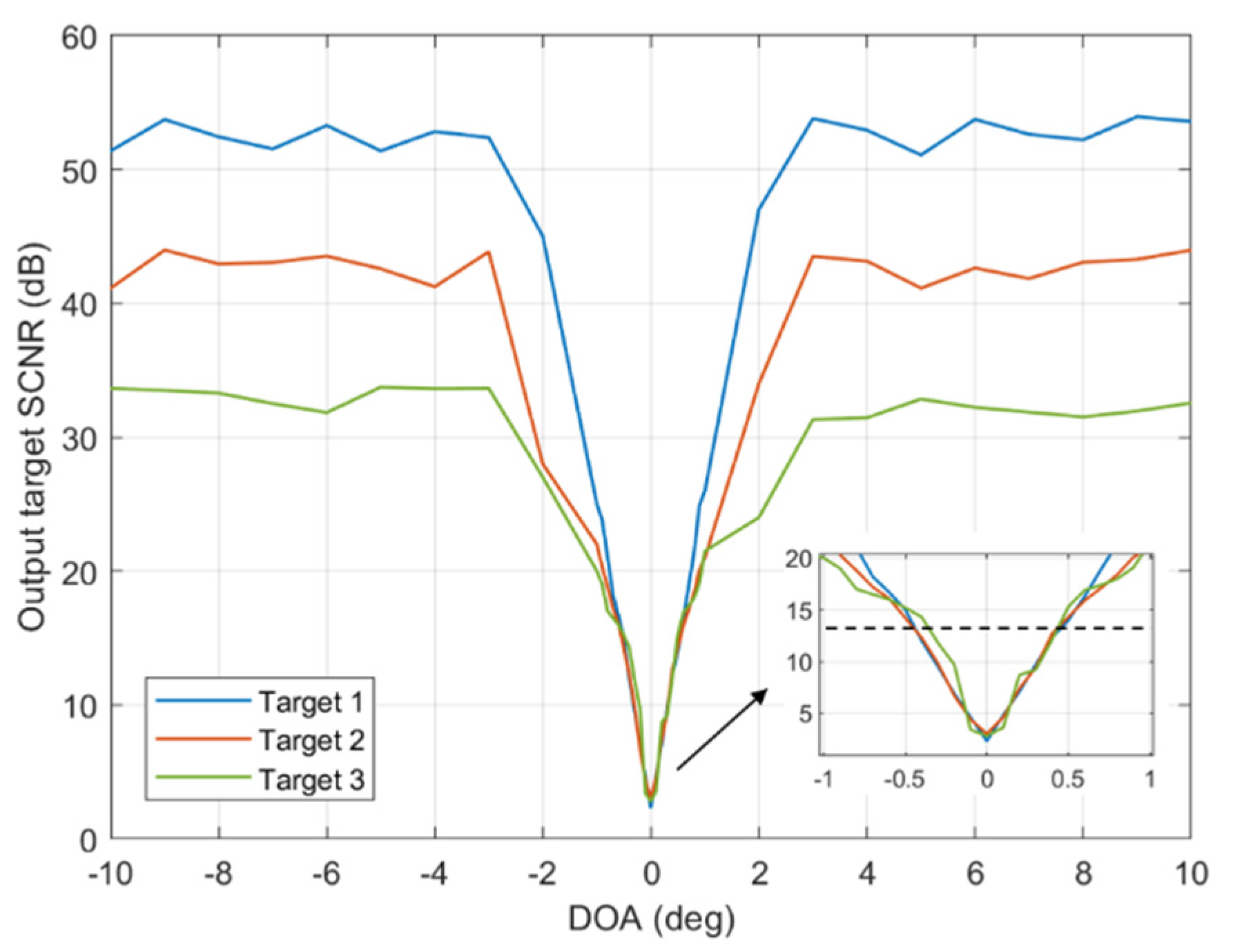

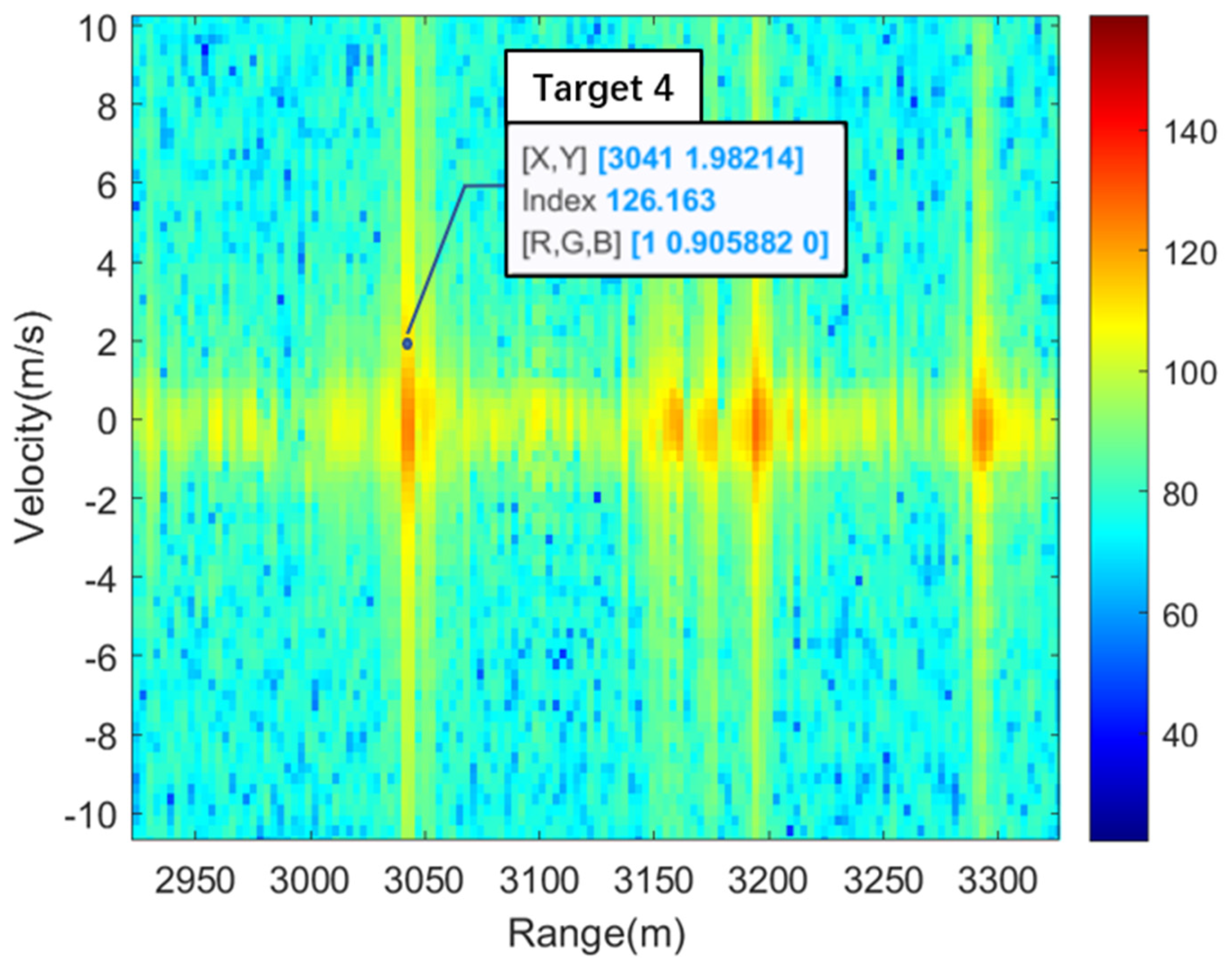
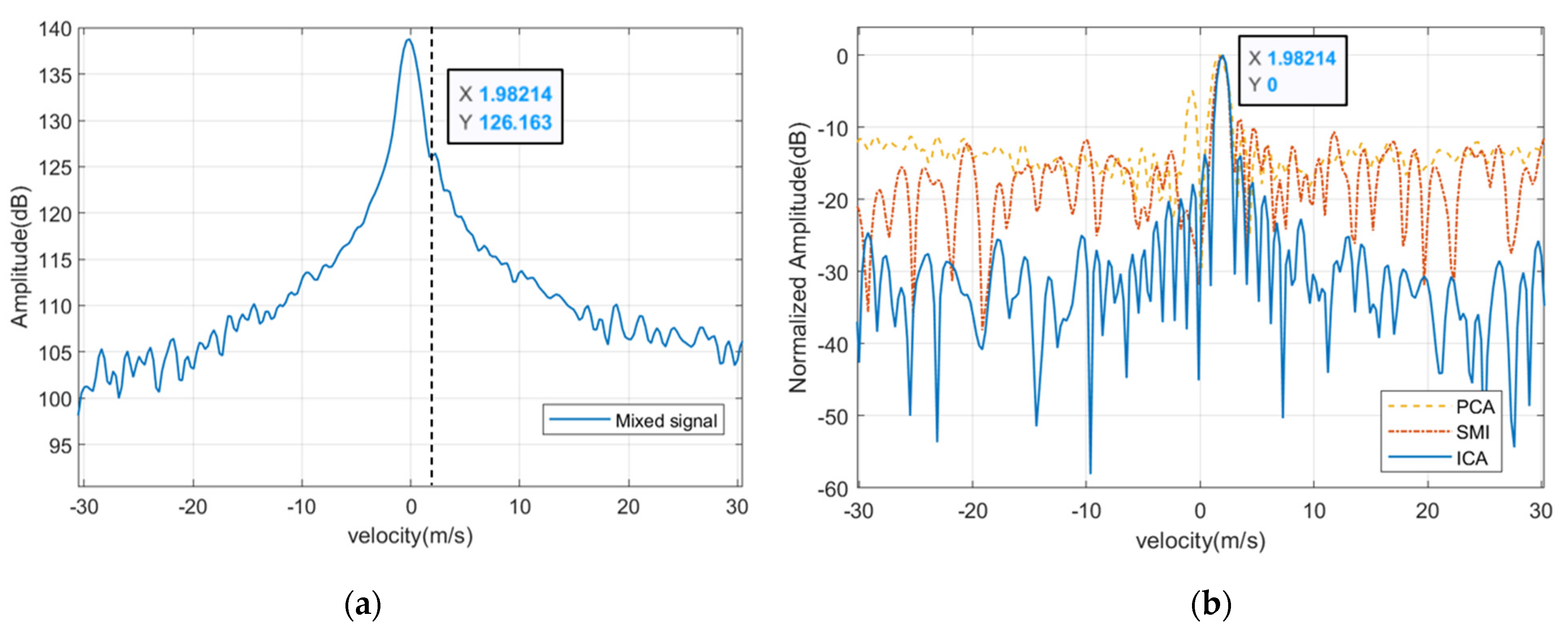

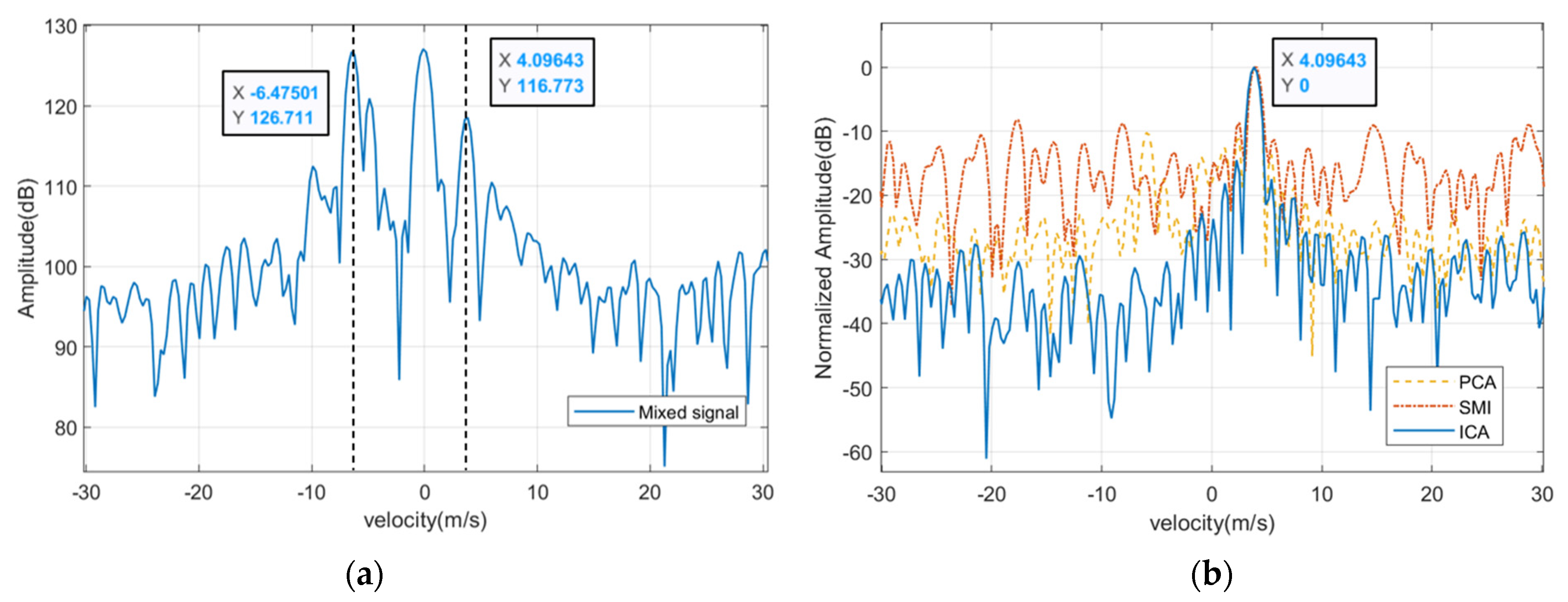
| Parameter | Value |
|---|---|
| Operating frequency | 3 GHz |
| Bandwidth | 40 MHz |
| Pulse repetition interval | 56 us |
| Number of pulses in one CPI | 900 |
| Number of Doppler sub-band | 6 |
| Maximum detect range | 8.4 km |
| Velocity measurement range | ±72 m/s |
| Parameter | Value |
|---|---|
| Number of antenna | 6 |
| Number of channels | 36 |
| Array aperture | 0.5 m |
| Virtual array aperture | 1 m |
| Element position | [0 0.1821 0.2681 0.3555 0.4206 0.5] m |
| Peak sidelobe level | −20 dB |
| 3 dB beamwidth | 6.2° |
| Type | Parameter | Value |
|---|---|---|
| Target 1 | Range | 500 m |
| Speed | 2 m/s | |
| Elevation | 4° | |
| SNR | 40 dB | |
| SCNR | −20 dB | |
| Target 2 | Range | 500 m |
| Speed | −4 m/s | |
| Elevation | 20° | |
| SNR | 30 dB | |
| SCNR | −20 dB | |
| Target 3 | Range | 500 m |
| Speed | 6 m/s | |
| Elevation | 10° | |
| SNR | 20 dB | |
| SCNR | −20 dB | |
| Ground clutter | Spectrum center | 0 m/s |
| 3 dB Spectrum width | ±2 m/s | |
| DOAs | [0° 0.1° 0.2° 0.3°] | |
| CNR | 60 dB |
| Results (dB) | Target 1 | Target 2 | Target 3 | |
|---|---|---|---|---|
| PCA | SCNR | 2.78 | 5.68 | 15.17 |
| Null level | −28.10 | −34.82 | −53.20 | |
| SMI | SCNR | 11.79 | 13.24 | 23.82 |
| Null level | −34.27 | −44.87 | −59.90 | |
| ICA | SCNR | 29.77 | 23.42 | 33.20 |
| Null level | −52.97 | −49.97 | −75.46 | |
| Type | Parameter | Value |
|---|---|---|
| Target 4 | Range | 3041 m |
| Speed | 2 m/s | |
| Height | 200 m | |
| Elevation | 3.8° | |
| Target 5 | Range | 5585 m |
| Speed | 4 m/s | |
| Height | 200 m | |
| Elevation | 2° |
Publisher’s Note: MDPI stays neutral with regard to jurisdictional claims in published maps and institutional affiliations. |
© 2022 by the authors. Licensee MDPI, Basel, Switzerland. This article is an open access article distributed under the terms and conditions of the Creative Commons Attribution (CC BY) license (https://creativecommons.org/licenses/by/4.0/).
Share and Cite
Yang, F.; Guo, J.; Zhu, R.; Le Kernec, J.; Liu, Q.; Zeng, T. Ground Clutter Mitigation for Slow-Time MIMO Radar Using Independent Component Analysis. Remote Sens. 2022, 14, 6098. https://doi.org/10.3390/rs14236098
Yang F, Guo J, Zhu R, Le Kernec J, Liu Q, Zeng T. Ground Clutter Mitigation for Slow-Time MIMO Radar Using Independent Component Analysis. Remote Sensing. 2022; 14(23):6098. https://doi.org/10.3390/rs14236098
Chicago/Turabian StyleYang, Fawei, Jinpeng Guo, Rui Zhu, Julien Le Kernec, Quanhua Liu, and Tao Zeng. 2022. "Ground Clutter Mitigation for Slow-Time MIMO Radar Using Independent Component Analysis" Remote Sensing 14, no. 23: 6098. https://doi.org/10.3390/rs14236098
APA StyleYang, F., Guo, J., Zhu, R., Le Kernec, J., Liu, Q., & Zeng, T. (2022). Ground Clutter Mitigation for Slow-Time MIMO Radar Using Independent Component Analysis. Remote Sensing, 14(23), 6098. https://doi.org/10.3390/rs14236098






